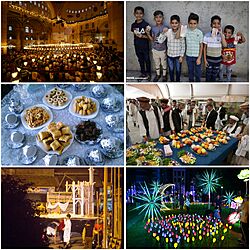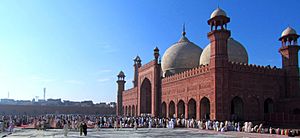Eid al-Fitr facts for kids
Quick facts for kids Eid al-Fitr |
|
|---|---|

|
|
| Also called | Lesser Eid, Sweet Eid, Sugar Feast |
| Observed by | Muslims |
| Type | Islamic |
| Significance | Commemoration to mark the end of fasting in Ramadan |
| Celebrations | Zakat al-Fitr, Eid prayers, gift-giving (Eidi), family and social gatherings, festive meals, symbolic decoration, charity |
| Date | 1–3 Shawwal |
| 2026 date | 20 March – 22 March |
| 2027 date | 9 March – 11 March |
| Related to | Ramadan, Eid al-Adha |
Eid al-Fitr is a very important festival for Muslims all over the world. Its name in Arabic means "Festival of Breaking the Fast." It marks the happy end of Ramadan, a month when many Muslims fast from sunrise to sunset. Eid al-Fitr is a time for prayer, delicious food, and celebrating with family and friends.
The festival lasts for one to three days. Because it's a time for sweet foods and treats, it is sometimes called the "Sweet Eid" or "Sugar Feast." It is one of the two main holidays in Islam, along with Eid al-Adha.
Contents
History of Eid al-Fitr
The tradition of Eid al-Fitr began a long time ago with the Prophet Muhammad. According to Islamic teachings, after he moved from the city of Mecca to Medina, he told his followers that God had given them two special days for celebration: Eid al-Fitr and Eid al-Adha. These have been celebrated by Muslims ever since.
How Eid is Celebrated
The celebration of Eid begins when a new crescent moon is seen in the sky. This marks the end of the month of Ramadan and the start of the next month, Shawwal.
Charity and Prayer
Before the Eid prayers, Muslims give a special donation called Zakat al-Fitr. This charity is given to help people in need so that everyone can enjoy the festival's food and fun. It is an important part of the celebration.
On the morning of Eid, many Muslims gather for a special prayer called the Salat al-Eid. This prayer is often held in a large open field, a community center, or a mosque. The prayer is a way to show gratitude to God. After the prayer, a leader called an imam gives a speech, or khutbah.
Celebrations with Family and Friends
After the prayers, the real party begins! People greet each other by saying "Eid Mubarak," which means "Blessed Eid." They visit family and friends, wear new clothes, and decorate their homes.
Food is a big part of Eid. Families cook special meals and share many sweet dishes and desserts. Children often receive gifts, money, and treats from older relatives. This gift money is known as Eidi. It is a day of joy, forgiveness, and community.
Celebrations Around the World
Muslims all over the world celebrate Eid, but different cultures have their own unique traditions.
In Asia
- In Indonesia, Eid is called Lebaran. Many people travel from big cities back to their hometowns to celebrate with their families. This journey is called mudik. Special foods like ketupat (rice cakes) and rendang (spicy meat dish) are served.
- In Pakistan and India, the night before Eid, called Chaand Raat (Night of the Moon), is very exciting. People go shopping for new clothes and gifts. Women and girls often decorate their hands with beautiful henna designs. A popular sweet dish is sheer khurma, made with milk, noodles, and dried fruits.
- In Turkey, the holiday is called Ramazan Bayramı or Şeker Bayramı (Sugar Feast). Children often go door-to-door in their neighborhoods to wish everyone a happy Bayram and receive candy or a small amount of money in return.
In the Middle East and Africa
- In countries like Saudi Arabia, families gather after prayers for a big meal. Children line up to receive money from the adults. People decorate their homes and wear new clothes.
- In Egypt, streets are decorated with colorful lanterns called fanous. Families often go to parks and gardens to celebrate together. Children receive Eidi and enjoy special treats.
- In Nigeria, Eid is known as Small Sallah. People greet each other by saying Barka Da Sallah. The celebrations can last for up to three days with lots of feasting and visiting relatives.
In Europe and the Americas
- In the United Kingdom and the United States, Muslims gather in mosques or community centers for prayers and celebrations. Many communities hold festivals with food, games, and activities for families.
- In some places, like New York City, Eid is a public school holiday, so children don't have to go to school. This shows how important the festival is to the community.
Why Does the Date of Eid Change?
You might notice that Eid al-Fitr does not fall on the same day every year in the standard calendar. This is because the Islamic calendar is a lunar calendar, which is based on the cycles of the Moon. The standard calendar used in most of the world is the Gregorian calendar, which is a solar calendar based on the Earth's trip around the Sun.
A lunar year is about 11 days shorter than a solar year. Because of this, the date of Eid al-Fitr moves back by about 10 or 11 days each year on the Gregorian calendar.
Images for kids
-
Eid al-Fitr mass prayer at Delhi's Jama Masjid, India
-
A family celebrating Eid in Tajikistan
-
Traditional Bayram wishes in lights on the Blue Mosque in Istanbul
See also
 In Spanish: Aíd al-Fitr para niños
In Spanish: Aíd al-Fitr para niños
- Eid al-Ghadir
- Shab-e-Barat
- Quds Day











